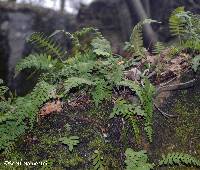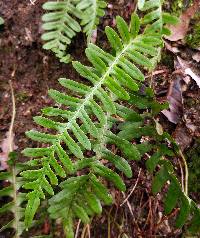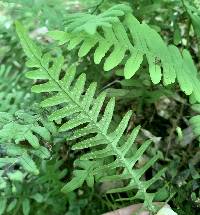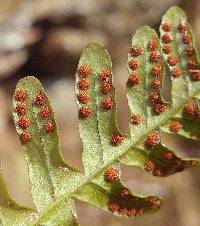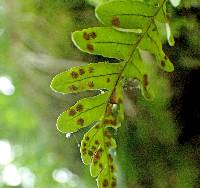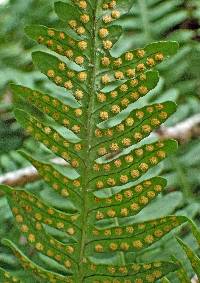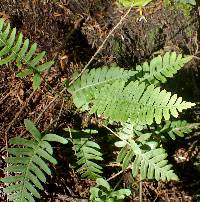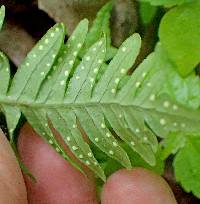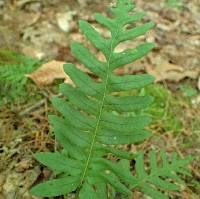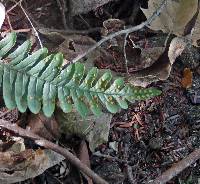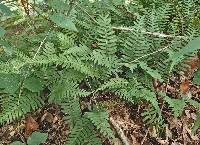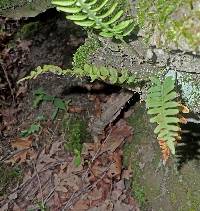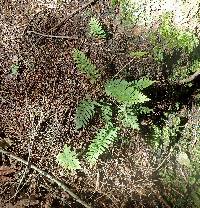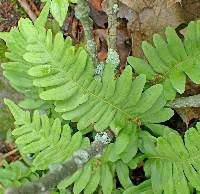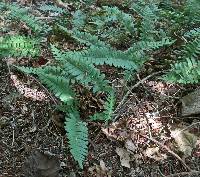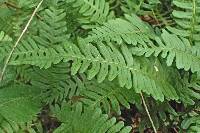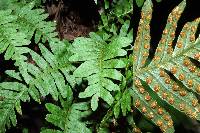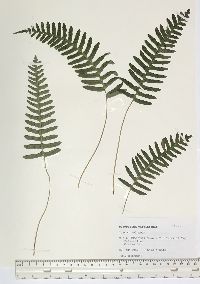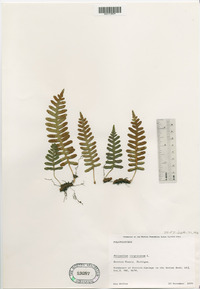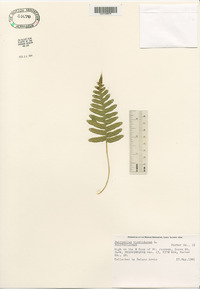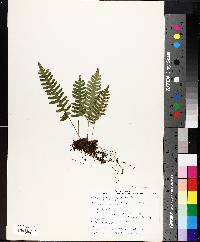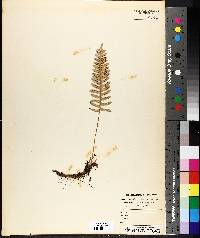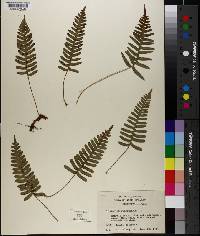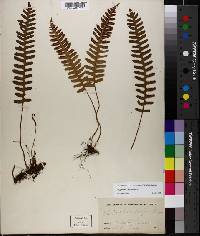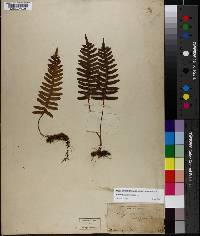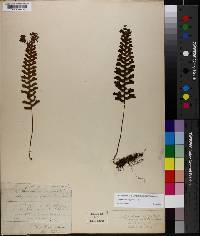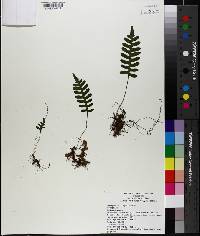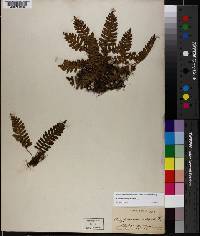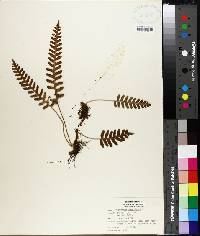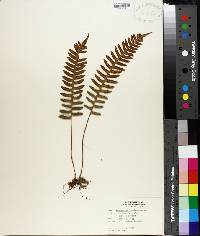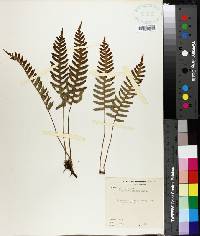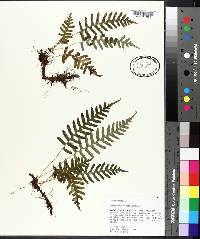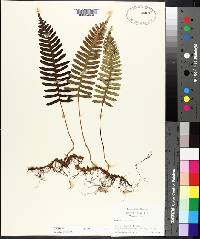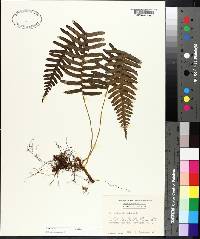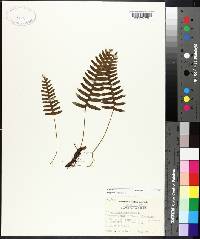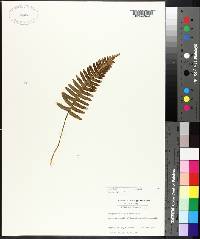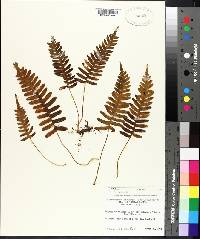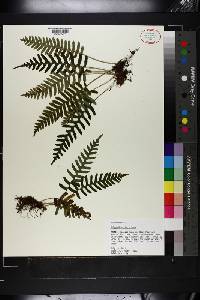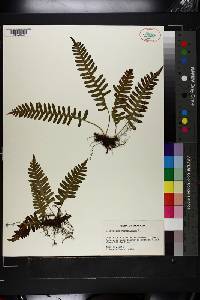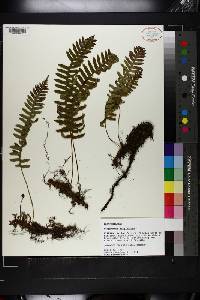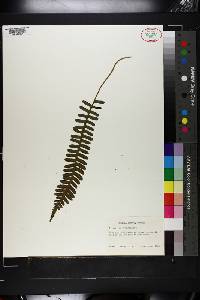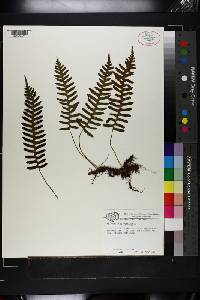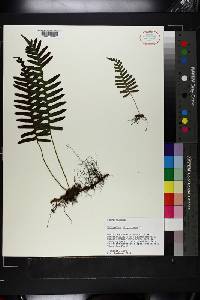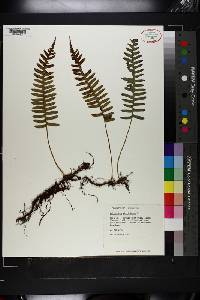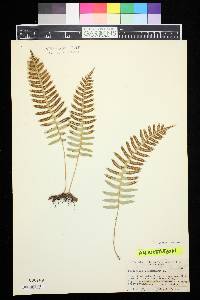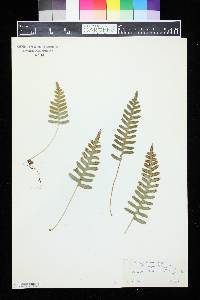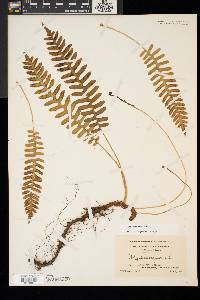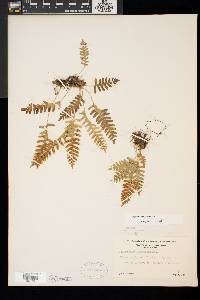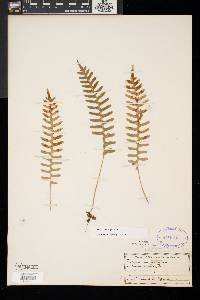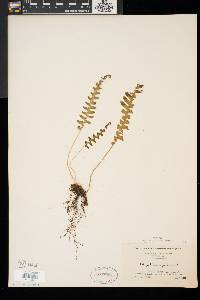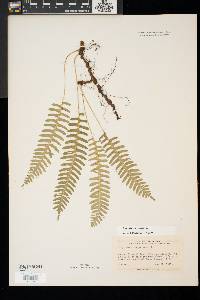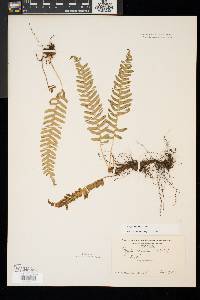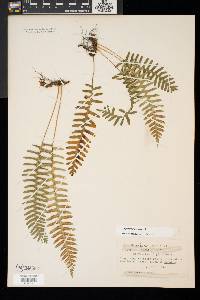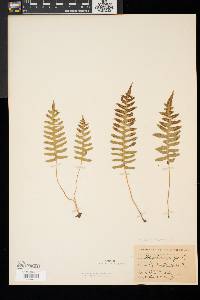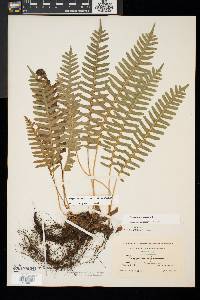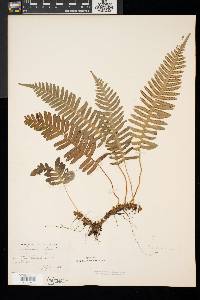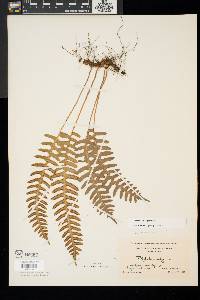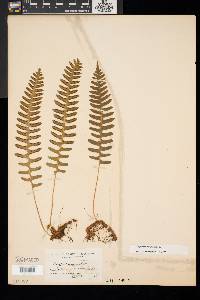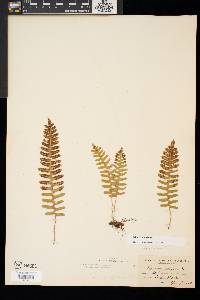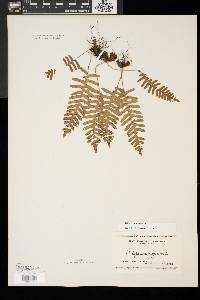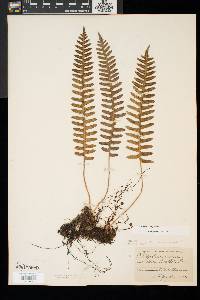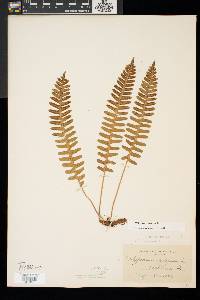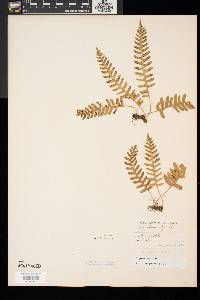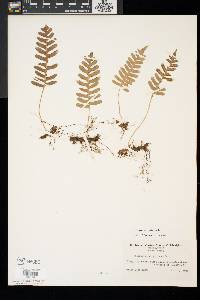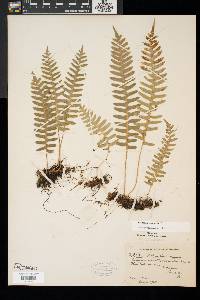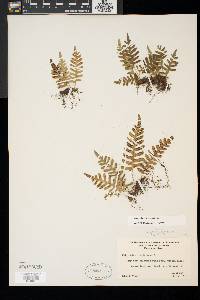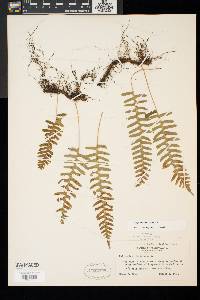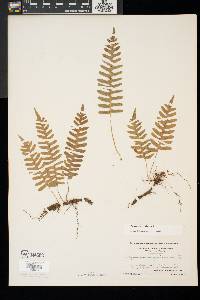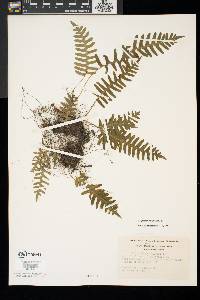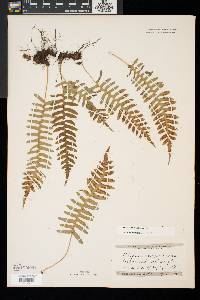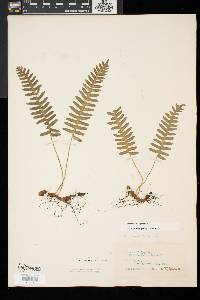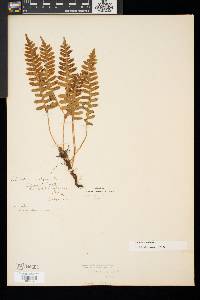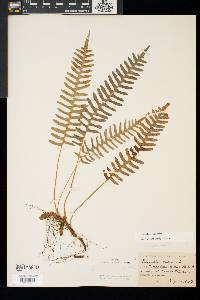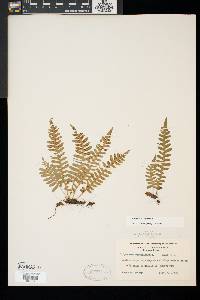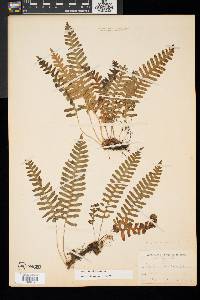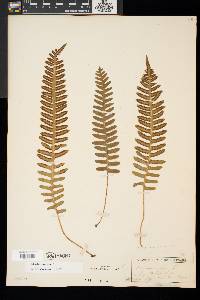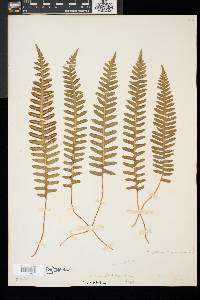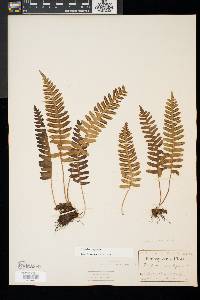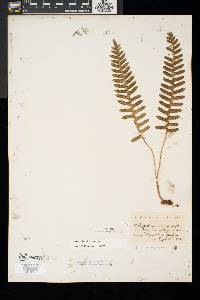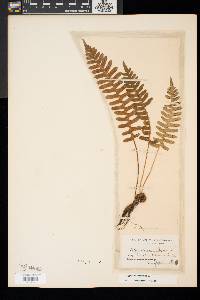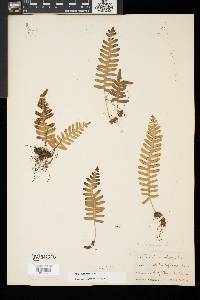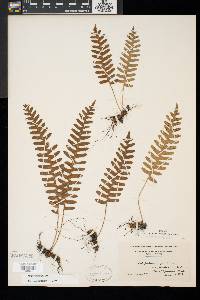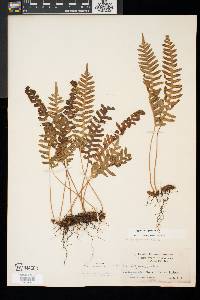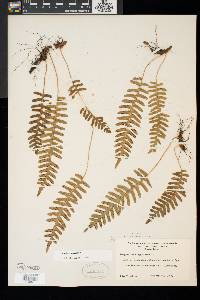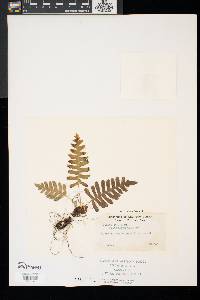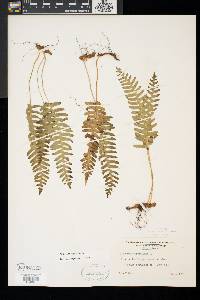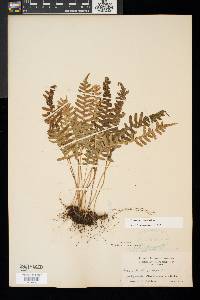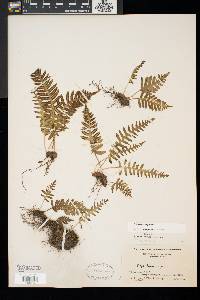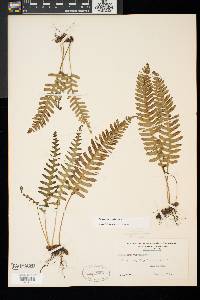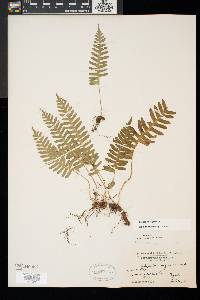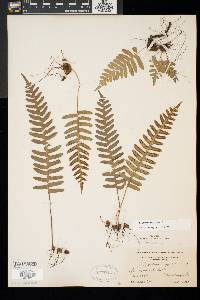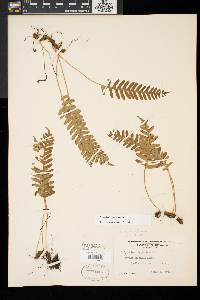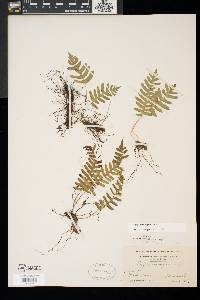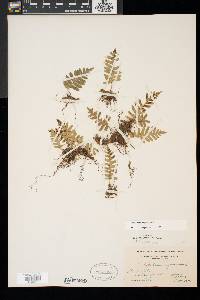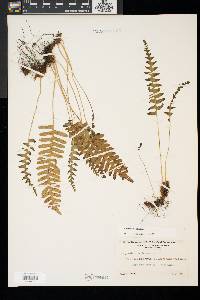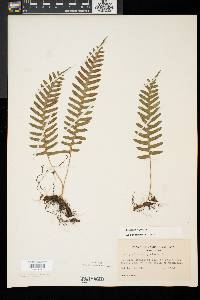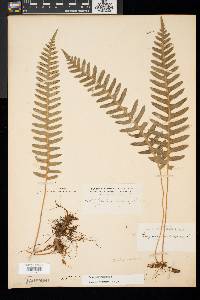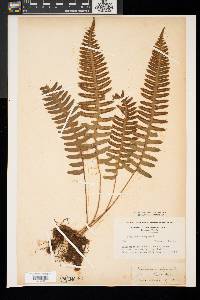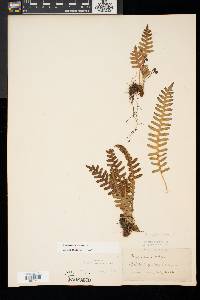
|
|
|
|
Family: Polypodiaceae
Rock Polypody, more...common polyploidy fern
[Polypodium virginianum f. bipinnatifidum Fernald, morePolypodium virginianum f. cambricoides F. W. Gray, Polypodium virginianum f. deltoideum (Gilbert) Fernald, Polypodium virginianum f. elongatum (Jewell) Fernald, Polypodium virginianum f. subsimplex Fernald, Polypodium vulgare f. projectum Fernald, Polypodium vulgare var. acuminatum Gilbert] |
Stems often whitish pruinose, slender, to 6 mm diam., acrid-tasting; scales weakly bicolored, lanceolate, contorted distally, base and margins light brown, sometimes with dark central stripe, margins denticulate. Leaves to 40 cm. Petiole slender, to 2 mm diam. Blade oblong to narrowly lanceolate, pinnatifid, usually widest near middle, occasionally at or near base, to 7 cm wide, somewhat leathery; rachis sparsely scaly to glabrescent abaxially, glabrous adaxially; scales lanceolate-ovate, usually more than 6 cells wide. Segments oblong, less than 8 mm wide; margins entire to crenulate; apex rounded to broadly acute; midrib glabrous adaxially. Venation free. Sori midway between margin and midrib to nearly marginal, less than 3 mm diam., circular when immature. Sporangiasters present, usually less than 40 per sorus, heads covered with glandular hairs. Spores more than 52 µm, tuberculate, surface projections more than 3 µm tall. 2 n = 148. Sporulating summer--fall. Cliffs and rocky slopes; on a variety of substrates; 0--1800 m; St. Pierre and Miquelon; Alta., Man., N.B., Nfld., N.W.T., N.S., Ont., P.E.I., Que., Sask.; Ala., Ark., Conn., Del., D.C., Ga., Ill., Ind., Iowa, Ky., Maine, Md., Mass., Mich., Minn., Mo., N.H., N.J., N.Y., N.C., Ohio, Pa., R.I., S.C., S.Dak., Tenn., Vt., Va., W.Va., Wis. Traditionally, two cytotypes have been recognized within Polypodium virginianum (I. Manton and M. Shivas 1953). Recent research has demonstrated that the tetraploid cytotype, which properly bears the name P . virginianum (R. Cranfill and D. M. Britton 1983), is an allopolyploid produced by hybridization between the diploid cytotype (here called P . appalachianum ) and P . sibiricum (C. H. Haufler and M. D. Windham 1991; C. H. Haufler and Wang Z. R. 1991). Although sometimes similar to its diploid parents in overall leaf morphology, P . virginianum has consistently larger spores, typically more than 52 µm (see additional comments under P . appalachianum and P . sibiricum ). Frequent hybridizations between P . virginianum and P . appalachianum form morphologically intermediate, triploid individuals with misshapen spores. Sterile triploids also result from hybridization between P . virginianum and P . sibiricum .
Perennial fern 10 - 40 cm tall Leaves: several, stalked, evergreen (remain green even in winter), usually without scales and hairs, somewhat leathery, over 5 cm long, 3 - 7 cm wide, usually widest near the middle, oblong to narrowly lance-shaped, but pinnately lobed. The leaf lobes are oblong, under 8 mm wide, and have rounded or blunt tips, and non-toothed to shallowly round-toothed edges. Rhizome: creeping, usually branched, often whitish and deep purplish, slender, 3 - 6 mm in diameter, and covered with lance-shaped, toothed, light brown scales with darker central areas. The rhizomes are acrid tasting. Leaf stalks: arising from rhizome, straw-colored, over 1 cm long, slender (up to 2 mm diameter), slightly winged. Spores: 64 per sac, all of one kind, transparent or yellowish, over 52 microns in diameter, single-sectioned (monolete), and bumpy or warty with projections over 3 microns in height. The spores are released from August to November, and give rise to the gametophyte (the sexual phase of the plant), which is small, green, heart-shaped or elliptic, and sits above the ground. Similar species: Polypodium virginianum is our only species of this genus and family within the Chicago Region. Probably the most easily confused species in our area would be in the genera Asplenium, Diplazium, and Woodwardia, but all members of those genera have linear or obviously longer than wide clusters of sporangia (sori) rather than rounded sori, and most of the species have compound leaves. In North America, there are two other species of Polypodium that are very similar to P. virginianum since they are the parent species of this tetraploid species: P. appalachianum and P. sibiricum. The more eastern parent, P. appalachianum, differs by having golden brown rhizome scales that are rarely bicolored, the leaf blades are more elongate and widest at the bottom, and the tips of the leaf lobes are much more pointed, or if rounded, narrowly so. The much more northern parent, P. sibiricum, differs by having spores less than 52 microns in diameter, the rhizome scales are usually entirely dark brown or sometimes have faint lighter edges, and the sterile sporangia in the sori (sporangiasters) do not have glandular hairs. Habitat and ecology: Rare in the Chicago Region, preferring rock cliffs, but also on steep slopes of wooded dunes in the eastern counties. Occurence in the Chicago region: native Notes: The Polypodiaceae family in the strict sense has about forty genera, with only seven of those in North America. Several of those genera used to be included in a very broad sense within the genus Polypodium. Still, the North American Polypodium species are a complex group with much hybridization occurring. They are related to the European taxa, especially P. vulgare, but yet are quite distinct. For more information, one should see the Flora of North America (1993). Author: The Field Museum Rhizome 1.5-3 mm thick, the scales 2.5-5 mm, basally cordate, apically filiform-attenuate, entire, concolorous, light brown; lvs 8-40 cm, the petiole mostly 3-15 cm, scaly only at the very base; blade narrowly oblong, mostly 3-6 cm wide, narrowed to an acuminate tip, the rachis sparsely scaly beneath; segments mostly 12-20 pairs, 3-7 mm wide, slightly denticulate, apically obtuse, glabrous; veins evident, free, mostly twice-forked, terminating in hydathodes; sori superficial, borne close to the midvein of the segments, the sporangia intermingled with long glandular golden hairs; 2n=74, 111, 148. On rocks and banks in circumneutral soil, or seldom on tree-trunks; Nf. to Yukon, s. to Ga., Ala., Ark., and S.D. Perhaps equally well treated as var. virginianum (L.) D. C. Eaton of a broadly defined, circumboreal P. vulgare L. Gleason, Henry A. & Cronquist, Arthur J. 1991. Manual of vascular plants of northeastern United States and adjacent Canada. lxxv + 910 pp. ©The New York Botanical Garden. All rights reserved. Used by permission. From Flora of Indiana (1940) by Charles C. Deam Local on the ledges of rocks in the area of the state where outcrops of sandstone and knobstone occur. There are, however, a few reports for it outside of this area. For example, Phinney reported it from the area composed of Delaware, Jay, Randolph, and Wayne Counties, saying: "Common. Moist woods". Van Gorder reported it from Noble County, saying: "A common plant of moist woods". Neither of these authors report the Christmas fern which occurs in their area, and, without doubt, their reports for this Polypodium should be referred to Polystichum. Bradner reported Polypodium from Steuben County but he also reported Polystichum. In this instance I think he may have had a sterile specimen of Polystichum and thought it was a Polypodium. This species was reported from the vicinity of Lake Michigan by three authors. I have always questioned these reports because my idea of the habitat of this species is that of outcrops of sandstone rocks. Doubtless Buhl had the same idea when he said (Amer. Midland Nat. 16: 250. 1935) that this report should be deleted for lack of confirming specimens. To my great satisfaction (because I always prefer to confirm rather than to deny a report) on May 30, 1935 through the courtesy of R. M. Tryon, Jr. I was shown a colony of this species on a wooded dune in the Dunes State Park. Mr. Tryon has had this colony under observation for several years and reports that it is gradually diminishing. The plant is growing in dense shade on the north side of a high dune which is well protected from the wind. Doubtless this species was infrequent to frequent in the dunes before it had to compete with fire and civilization. …… Indiana Coefficient of Conservatism: C = 10 Wetland Indicator Status: N/A |
|
|
|


